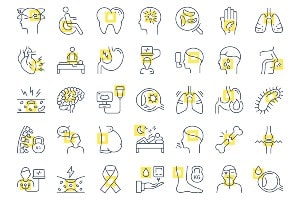About Childhood Obesity

Learn about the disease, illness and/or condition Childhood Obesity including: symptoms, causes, treatments, contraindications and conditions at ClusterMed.info.
Childhood Obesity

| Childhood Obesity |
|---|
Childhood Obesity InformationChildhood obesity facts
How prevalent is childhood obesity?The national statistics regarding childhood obesity prevalence (total number of cases in the pediatric population) have risen remarkably. In the 1970s and 1980s, approximately 5% of children were obese. By 2000, over 13% were obese, and 2010 statistics indicate pediatric obesity to be leveling off at approximately 18% of the population. (In contrast, approximately 35% of adults are obese.) While the frequency of obesity appears to be leveling off, the amount of excess weight has continued to rise (for example, BMI value has risen higher per individual).The Midwest and South have the highest frequency of obesity (31%), with Arkansas, Mississippi, and West Virginia having the highest frequency (36%) and Colorado having the lowest (21%). Of the remaining states, 26 have an obese population of over 25%; 18 states have over 30% of their population being obese. In 2000, no states had more than 30% of their population considered obese. As of 2014, no state had less than 20% of its adult population classified as obese.The Centers for Disease Control and Prevention's web site (http://www.cdc.gov) has an excellent demonstration of the rise in obesity over the last 30 years by using an interactive map of the United States (http://www.cdc.gov/obesity/data/trends.html#State).An area of concern is that the statistics gathered in many studies are self-reported by the individual and may therefore be overly optimistic (for example, purposely underestimating weight and overestimating height). Is it possible to prevent childhood obesity?Benjamin Franklin's famous dictum "an ounce of prevention is worth a pound of cure" is ironically the perfect approach to childhood obesity. The CDC has recently raised the notion that should the alarming increase in childhood obesity not be reversed, the consequences may make the current pediatric population be the first generation to not exceed the life span of their parents. Studies have indicated that childhood obesity must be attacked prior to the teen years. Twenty percent of obese 4-year-old children will grow up to become obese adults; 80% of obese teens will continue their obesity into adulthood. All of the above-reviewed consequences of pediatric obesity are brought forward into the adult years. Here are three amazing observations: (1) children 6 months to 6 years of age watch an average of two hours of television per day; (2) 18% of children less than 2 years old have a TV in their bedroom. Of this toddler population, 34% watched more than two hours of TV daily; (3) children 8-18 years of age spend an average of seven and a half hours per day involved with entertainment media activity such as television, computer games, video games, and cell-phone calls/texting.Social and cultural changes are necessary to effectively address the pediatric obesity epidemic. A basic approach would entail the following:
What are childhood obesity symptoms and signs?Measurement of height and weight are the most commonly used tools to quickly evaluate the proportionality of children. These measurements allow calculation of the body mass index (BMI). It is important to consider the physique of the individual. While having a weight in excess of what would be expected for a certain height is most commonly a documentation of excessive fat tissue, certain individuals may be overmuscled (for example, weightlifters). With the exception of very rare bone diseases, the idea of an individual's excessive weight due to being "big boned" is an urban myth. What are risk factors for childhood obesity?There are several substantial risk factors for the development of pediatric obesity.
What are the risks, complications, and long-term health effects of childhood obesity?The consequences of childhood obesity may be grouped into three areas: physical, mental, and economic. The known physical side effects of obesity are multiple and broad spectrum in character. These include the following:
What causes childhood obesity?Most obesity is caused by excessive daily caloric intake relative to daily caloric expenditure. Excessive intake of calories is most commonly associated with poor food-quality choices (for example, fast-food high in fat and sugar calories) but may also result from over-ingestion of "healthy foods." The simple biological fact is that all excessive calories (regardless whether triple cheese meat lovers pizza vs. fat free yogurt with berries) will be stored by the body and only as fat. Attempts at only reducing caloric intake without increasing caloric utilization (read: 60 minutes daily vigorous exercise) will only help temporarily. If calorie restriction is the sole approach toward losing weight, the body's metabolism adopts a conservation mode and learns how to get by on fewer calories. Adding physical activity to the calorie-burning equation encourages breakdown of excessive carbohydrate and fat stores, allowing for more functional and long-term health.Body weight (not necessarily excessive body fatness) is a reflection of genes, metabolism, behaviors, culture, and socioeconomic status. These relatively infrequent causes of obesity will be detailed below. What is childhood obesity? How do health-care professionals diagnose childhood obesity?In order to systematically describe obesity, the concept of body mass index (BMI) was developed. BMI is the ratio between an individual's weight to height relative to their gender and age. BMI addresses the following question: Is the weight of the subject in excess of what is healthy for a given height? Generally (but not always), BMI correlates with the amount of body fat, but it is not a measurement of fat. An individual who has more than the average muscle mass for a given height (for example, weightlifters) will have an elevated BMI but clearly will not be obese. Nomograms for both adults and children have been developed to graphically represent the range of normal when measuring BMI. An individual is overweight when their BMI is between 25.0-29.9. Obesity is defined as a BMI greater than 30.0. Many web sites have calculators to measure BMI (for example, http://www.cdc.gov/healthyweight/assessing/bmi/). Measuring body fat may be done via skin-fold-thickness measurement, waist-to-hip-circumference ratio, and neutral buoyancy (water displacement) measurements. BMI is not used for children under 2 years of age, and instead growth charts should be used to identify any weight issues. What is the treatment for childhood obesity?The treatment for childhood obesity is no different than many diseases -- determine the cause(s) and control or eradicate it (them). Since the overwhelming number of obese individuals are consuming too many calories relative to their energy expenditure ("burning them off"), therapy is directed toward reversing this metabolic equation. Simply put, consume fewer calories and use more up. There are many dietary programs that attempt to address this issue. None is superior over the long term unless the participant embraces these nutritional changes as part of a larger lifestyle recommitment. Drugs and surgery should be restricted to severe cases of childhood (and adult) obesity. What research is being done on childhood obesity?The National Institutes for Health (NIH) web site lists over 300 open studies currently focused on the pediatric age range (http://clinicaltrials.gov/search/open/term=obesity+%5BCONDITION%5D+AND+child+%5BAGE-GROUP%5D). These studies are exploring the various causes and associations of obesity, the physical, emotional, and financial impact of pediatric obesity, as well as a broad array of management tools, potential medications, and other therapies for the treatment of childhood obesity. Where can people find more information on childhood obesity?Accurate and timely information regarding pediatric obesity may be found at the following web sites:Centers for Disease Control and Prevention (CDC)http://www.cdc.gov/obesity/childhood/index.htmlhttp://www.cdc.gov/HealthyYouth/obesity/index.htmAmerican Dietetic Associationhttp://www.eatright.orgNational Institutes for Health (NIH)http://www.nlm.nih.gov/medlineplus/obesityinchildren.html |
More Diseases
A | B | C | D | E | F | G | H | I | J | K | L | M | N | O | P | Q | R | S | T | U | V | W | X | Y | Z
Diseases & Illnesses Definitions Of The Day
- Noncancerous Colloid Thyroid Nodule (Thyroid Nodules) ‐ How are thyroid nodules diagnosed?, Introduction to thyroid nodules …
- Skin, Laser Resurfacing (Laser Resurfacing) ‐ CO2 Laser Resurfacing, Complications of Laser Skin Resurfacing …
- Malignant Fibrous Histiocytoma (Bone Cancer Overview) ‐ Are there any treatments or medications that relieve bone cancer pain? …
- Double Vision ‐ Is it possible to prevent double vision?, What are the symptoms and signs of double vision? …
- Ageusia (Taste Disorders) ‐ Are taste disorders serious?, Can taste disorders be treated? …
- Autism Screening and Diagnosis ‐
- Alpha-fetoprotein Blood Test ‐ In which situations are high blood (serum) levels of AFP used as a tumor marker? …
- Polymyalgia Rheumatica ‐ How do health care professionals make a diagnosis of polymyalgia rheumatica? …
- Stump Appendicitis (Appendicitis) ‐ Appendicitis definition and facts, Are there long-term consequences of appendectomy? …
- Gonorrhea (Gonorrhea In Women) ‐ Gonorrhea facts, How is gonorrhea diagnosed?, What are sexually transmitted diseases (STDs)? …